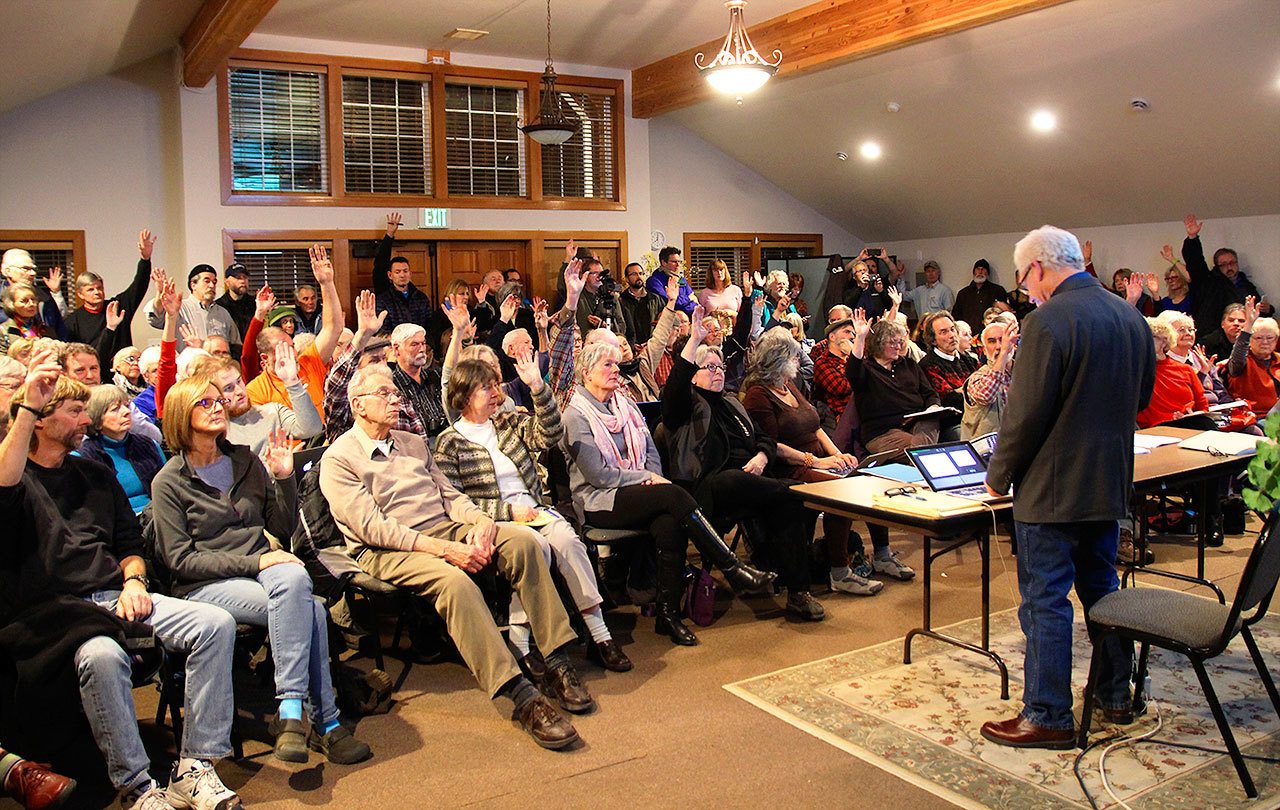A water sample from a well at a former fire training area at Naval Air Station Whidbey Island tested for a potentially toxic chemical at more than 800 times the EPA’s lifetime advisory level.
The fact caused a stir during a meeting Thursday night that drew well over 100 people who crowded into seats and lined the walls at the Pacific Rim Institute in Central Whidbey.
The meeting was held by residents concerned about the Navy’s ongoing testing of drinking-water wells on Whidbey Island.
The Navy confirmed this week that three private wells near the Outlying Field Coupeville and one near the Ault Field base near Oak Harbor tested above the lifetime advisory level for chemicals found in firefighting foam.
The EPA set a lifetime advisory level earlier this year for perfluorooctane sulfonate and perfluorooctanoic acid at 70 parts per trillion.
Central Whidbey residents Steve Swanson and Richard Abraham led the meeting to discuss the findings and the ongoing testing. Swanson, a retired ER physician, was one of the people whose well tested above the advisory level.
He said his well tested at 440 parts per trillion.
This is why, he surmised, that two wells near each other may have different levels of the chemical.
The chemicals are excreted from the body very slowly, Swanson explained. The only way to get rid of a concentration in the body is to drink water that is completely free of the chemicals.
Abraham spoke about the history of the chemicals and other areas that were contaminated. He said he spent a career running organizations and providing assistance to organizations responding to toxic pollution problems.
“What has happened to you has happened in other communities,” he said.
As several people pointed out, Navy officials have said they don’t know if the Navy is responsible for the contamination. The chemicals were in many items, such as Teflon pans and fast-food wrappers. Some people, for example, have pointed to the closed landfill near OLF Coupeville as a possible cause.
Island County Public Health Director Keith Higman, however, said it seems unlikely that a landfill could be the source of this type of contamination.
Higman said the amount of the chemicals in foam is much higher than in other sources.
The Health Department is investigating whether fire departments on the island may have used the foam, particularly in training, he said.
It’s likely that fire districts used the product, called aqueous film forming foam, in the past. It’s used to smother petroleum-fed fires, according to Chief Ed Hartin, with Central Whidbey Fire &Rescue.
The department now uses foam that doesn’t contain the two chemicals.
Firefighters at the Navy base also no longer use foam containing the chemicals for practice, but they do still carry them in case of an aircraft crash, according to a state Health Department official.
Several meeting attendees suggested the cause of the contamination may be, at least in part, related to a Prowler crash at OLF Coupeville in 1982.
One speaker said a witness remembered seeing foam being used on the crash.
Investigators are still looking into that report, but were told that firefighting foam was not used on the crash because it occurred in a heavily wooded area, according to Mike Welding, public affairs officer for NAS Whidbey.
The witness said firefighters had trouble getting to the plane and the fire was extinguished before they finally arrived.
Welding said officials would like to speak to anyone who remembers the crash or who may have witnessed the use of the foam.
Navy hydrogeologists will be investigating the sources of the contamination; they will be mapping test results to figure out how water flows underground.
The Navy promised to supply people with an alternative source of clean drinking water if their wells are tested at above the advisory level.
Higman said he doesn’t know what may happen, as far as liability, if the source turns out to be something unrelated to the Navy.
He emphasized that the two chemicals are unregulated and that the level set by the EPA is just an advisory.
The Navy isn’t required to conduct the well tests, but is doing so at bases nationwide as a proactive precaution and to be a good neighbor, Higman said.
The Navy base will issue updated testing results each Tuesday, Welding said.
Information released will include the number of wells at Ault Field and OLF Coupeville that are found have concentrations of the chemicals above the advisory level.



